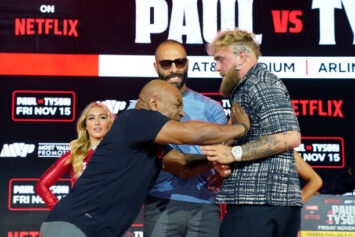Each Superman film over the past three decades had its own character and personality. Richard Donner’s Superman was campy and humorous. Richard Lester’s took the comic act to another level in Superman II. For Superman III, Lester scrapped another semblance of serious tone by casting Richard Pryor as a villain. Bryan Singer’s was a sappy romance, with a dearth of action and much too steeped in ‘80s nostalgia.
Director Zack Snyder’s Superman on PEDs vision is a complete 180 from Superman Returns. Snyder is the Victor Conte of beefed up special effects. It’s completely humorless, Superman’s costume is sleeker, the action is faster and for some reason Clark Kent can’t takeoff without creating potholes or damaging our ear drums.
Superman (Henry Cavill) is bigger, literally and so is the action and destruction. He’s also faster and the plot fast forwards just as quickly. By the end of the first hour, Lois already knows Superman’s secret identity. In a matter of 15 minutes, Clark goes from a confused 33-year-old alien to discovering his Kryptonian origins and in a matter of minutes, he’s donning the blue tights and red cape.
As a result of this hurried pace, the complexity of the character’s that existed in Christopher Nolan’s Dark Knight universe weren’t present here. Man of Steel is the physically gifted film with flawed fundamentals.
The film opens with Kal-El’s birth on Krypton, and immediately accelerates into the action with Jor-El (Russell Crowe) staging a dramatic escape from General Zod’s (Michael Shannon) forces in the midst of a civil war that culminates with him jettisoning Kal-El in a shuttle.However, Kryptonians make the mistake of sentencing Zod and his crew to “300 cycles of somatic reconditioning” in the Phantom Zone instead of sentencing them to life in prison on a planet that would explode in a week.
Lois (Amy Adams) and Superman (Henry Cavill) don’t have much chemistry, but they became love interests almost immediately.
By utilizing and marketing Christopher Nolan’s role as a producer, Warner Bros. was inviting comparisons to the Dark Knight trilogy. Nolan’s trilogy is the standard by which all comic book films are measured.
Like Nolan’s Batman origin story, Man of Steel had its own set of flashbacks, but these were too aimless by comparison and continuously disrupted the flow. Scenes of a young Clark stalking through Iowa cornfields that offered no context could have been cut in half.
For example, there’s a five-minute scene featuring a young Clark Kent running out of class and locking himself in a broom closet. The scene has no significance in the grand scheme of things, except to act as plot filler and a bathroom breaks for moviegoers.
The blame can be laid on the script and story structure. Screenwriters are like the fine print on a prescription bottle. Nobody ever pays attention to them, but it’s in your best interests to check it out anyways.
Christopher’s brother, Jonathan wrote the screenplays for the final two installments in Nolan’s superhero trilogy, and is the anti-M. Knight Shyamalan. His name usually doesn’t get much mainstream love, but if he’s attached to a project, then you can bank on a complex, story.
Man Of Steel’s writer, David Goyer, has a track record that is a little more inconsistent. He’s had a few successes, but there are also some clunkers on his resume (ahem, Jumper).
Man of Steel repented for the sins of its predecessor, which was blasted for its paucity of fight sequences, by decimating entire towns and cities in the last hour. However, Goyer and Snyder failed to offer the action in appropriate doses. At a certain point, you grow numb to the carnage.
It was a solid effort, but it was too big of a story for an origin story. Everything is too big and happens too fast. Instead, it would have been more beneficial if the story had honed in on a smaller, more personal threat for Clark Kent instead of immediately going for the fireworks of a half-baked end of humanity trope.
In addition to everything, this version did so much reimagining of the Superman lore that it’s almost unrecognizable. Whether that’s good or bad is up to personal preference. The S on Superman’s chest doesn’t stand for Superman in Snyder and Goyer’s adaption. According to what Superman tells Lois, it means hope on his planet. Don’t get me wrong, if you’re one of the few people that didn’t contribute to Man of Steel’s $125 million at box office, I’d suggest you go see it. But only because I hope the sequel is better.



